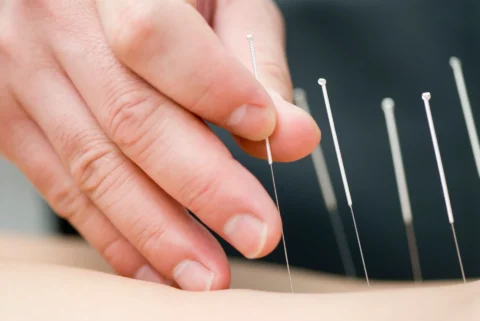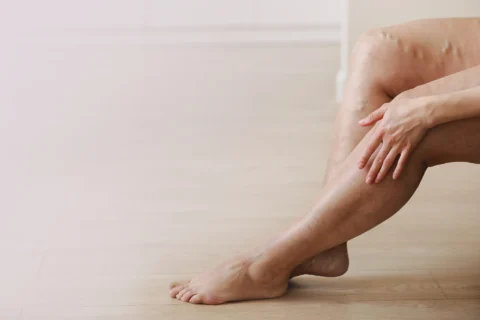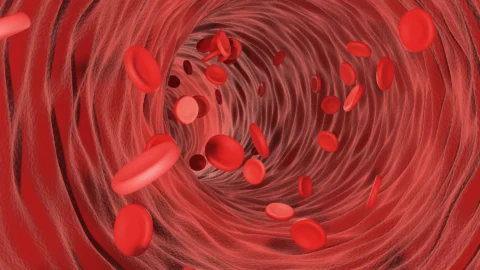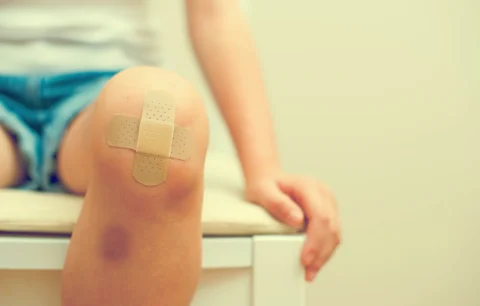Patients with sleep apnea in the United States are approximated to be 4% for women and 9% for men, with prevalence increasing as people age. Those who perform sleep studies have been seeing a rise in the occurrence of this sleep disorder including in adolescents who present with obesity, a known risk factor of chronic venous insufficiency.
So can obstructive sleep apnea cause chronic venous insufficiency? Through a procoagulant state, obstructive sleep apnea is correlated with chronic venous insufficiency, especially because of the coexistence of obesity in these sleep-disordered patients. Other cardiovascular diseases are also linked to obstructive sleep apnea through a number of factors such as sympathetic activation and oxidative stress, among others.
The Link Between Obstructive Sleep Apnea and Chronic Venous Insufficiency
Studies link obstructive sleep apnea to the development of venous thromboembolism, under which are pulmonary embolism and deep vein thrombosis. With obesity as an important coexisting condition that may affect the exacerbation of the procoagulant state where blood viscosity is increased, these mechanisms are pointed to be the link between obstructive sleep apnea and chronic venous insufficiency:
- Hypercoagulability – Hypercoagulability is the state of increased blood coagulability exhibited by patients with obstructive sleep apnea due to the hypoxia or lack of oxygen delivered to the tissues associated with the apneic events of this sleep disorder. This is because hypoxia causes increased platelet reactivity, increased concentrations of coagulation factors, and impaired fibrinolytic activity.
- Endothelial Dysfunction – Impairments in the endothelial function characterized by a decrease in the flow-mediated dilation of the brachial artery are seen in obstructive sleep apnea. The exact mechanisms behind endothelial dysfunction are unclear, although possible factors include intermittent hypoxia, intrapleural pressure swings, and recurrent arousals.
- Venous Stasis – Obesity leads to the development of venous stasis, increasing the risk of these patients to venous thromboembolism. Obese patients often present with obstructive sleep apnea, therefore linking the two.
Similarly, studies also show that the fluid accumulation in the legs brought by chronic venous insufficiency contributes to the development of obstructive sleep apnea due to its redistribution to the neck when patients with sleep apnea go to sleep.
This is demonstrated in a study on nonobese subjects with sleep apnea who are made to wear compression stockings. They have been shown to have reductions in leg and neck fluid accumulation as compared to the period of time that this population of patients that are not wearing the compressive stockings.
Potential Mechanisms Linking Obstructive Sleep Apnea To Chronic Cardiovascular Disease
Patients with sleep apnea may present with acute cardiovascular effects associated with this sleep disorder. These effects include:
- Hypoxia, hypercapnia, and apnea – When apnea or the brief moment of cessation of breathing occurs, it leads to hypoxia (the lack of oxygen delivery to the tissues) and hypercapnia (the increase in carbon dioxide concentration in the blood). When these 2 processes occur, they mediate a chemoreflex-mediated increase in sympathetic activity that results in the constriction of blood vessels. This in turn leads to an increase in arterial pressure, predisposing patients to venous thromboembolism.
- Arousal – Sleep fragmentation characterized by periods of apneic or hypopneic episodes during sleep lead to sleep deprivation in patients with obstructive sleep apnea. This predisposes these patients to accidents, increased production of inflammatory cytokines, impaired glucose tolerance, and increased blood pressure levels.
Similarly, aside from chronic venous insufficiency, chronic cardiovascular morbidity is also linked to obstructive apnea. However, more epidemiologic studies must be done for more definitive evidence for this observation because people with sleep apnea also often present with coexisting cardiovascular disease conditions such as the following:
- Hypertension – The development of hypertension is associated with obstructive sleep apnea, as seen in the findings of the Wisconsin Sleep Cohort, where those who have sleep apnea are shown to have an increased risk of developing new hypertension. Hypertensive patients with concomitant obstructive sleep apnea are also observed to have lowered daytime blood pressure upon the treatment of their obstructive sleep apnea.
- Cardiac ischemia – Myocardial infarction or heart attack may occur during sleep in patients with obstructive sleep apnea due to decreased oxygen saturation brought by the acute and chronic stresses from this condition. Moreover, an increased risk towards the development of OSA may also occur due to the changes in cardiac function due to the changes incurred after an episode of myocardial infarction.
- Cerebrovascular disease – A clinical history of snoring that’s characteristic of obstructive sleep apnea is implicated with an increased risk of stroke. This may be due to a decrease in the blood flow towards the brain brought by the apneic events associated with obstructive sleep apnea. Other pathologic changes in the hemodynamic, vascular, and inflammatory functioning of the body brought by obstructive sleep apnea also contribute to this increased propensity to develop stroke.
- Congestive heart failure – This cardiac disease is associated with obstructive sleep apnea possibly due to the development of systolic and diastolic dysfunction that predisposes a patient to develop congestive heart failure. Similarly, patients with congestive heart failure also exhibit periodic breathing, which affects the normal functioning of respiratory mechanisms leading to an increased risk of the development of obstructive sleep apnea.
- Cardiac arrhythmias – Pathological changes in cardiac rhythm have been demonstrated in patients with obstructive sleep apnea, with the most common being severe sinus bradycardia (slowing down of the heart rate). These cardiac arrhythmias occur even without other cardiovascular diseases and may even disappear upon the management of obstructive sleep apnea.
Potential factors that lead to these cardiovascular events include abnormalities that stem from impairments in the functioning of the neural, humoral, vascular, and inflammatory mechanisms of the body. These include the following:
- Sympathetic activation
- Oxidative stress
- Inflammation
- Metabolic dysregulation
Diagnosis Of Chronic Venous Insufficiency

The clinical diagnosis of chronic venous insufficiency entails looking at a patient’s clinical history for risk factors associated with this disease, such as a family history of cardiovascular risk factors like congenital heart disease and deep vein thrombosis. Physical examination may also be done to observe the clinical signs and symptoms associated with this disease.
Clinical diagnosis of this venous disease may also be confirmed through visualization of the veins via non-invasive and invasive means such as the following:
| Non-Invasive Testing | Invasive Testing |
| Venous duplex imagingAir plethysmographyComputed tomography VenographyMagnetic resonance venographyPhotoplethysmographyStrain gauge plethysmographyFoot volumetry | Contrast venographyIntravascular ultrasoundAmbulatory venous pressure |
Management of Chronic Venous Insufficiency
Several types of therapy in patients with chronic venous insufficiency exist to relieve them of the signs and symptoms brought by venous hypertension that causes a chronic accumulation of fluid in the lower extremities, venous compression, and postthrombotic syndrome associated with CVI. Management strategies include the following:
- Diet and lifestyle modification – Obesity is a known risk factor of CVI, necessitating the need for regular exercise and healthier diet choices to facilitate losing weight. Other contributory factors to CVI such as prolonged standing and sitting should be reduced as well.
- Pharmacologic management – Medications that help manage the signs and symptoms associated with CVI include diuretics for edema and topical steroid cream and ointment for skin inflammation. Herbal supplements with venoactive properties may also help manage chronic venous insufficiency.
- Interventional procedures – Interventional procedures are minimally-invasive procedures to reduce venous valvular incompetence to avoid the reliance on surgical treatment in managing this disease entity. These may be done for a wide variety of reasons, including cosmetic improvement and for helping manage chronic venous ulcers.
- Mechanical interventions – Mechanical interventions entail the use of medical-grade devices or garments to oppose fluid accumulation, venous distention, and venous wall tension, along with an improvement in calf muscle pump function. Under this type of CVI treatment are the devices and garments used for compression therapy.
- Surgical treatment – Surgery is considered in patients with recurring CVI and ulcers. With the aim of reducing venous reflux and venous hypertension, surgical treatments are done to produce new paths for blood to flow called anastomoses or lead to the creation of grafts. Surgical treatments include veno-venous bypass (Palma procedure), endovenous angioplasty, iliac vein stenting, phlebectomy, among others.
High-Quality Outpatient Vein Treatments at Vein Center Doctor
At Vein Center Doctor, we provide an expert opinion on the management of varicose veins and other sequelae of chronic venous insufficiency found especially in the leg veins. We offer high-quality outpatient vein treatments such as radiofrequency ablation, endovenous laser treatment, sclerotherapy, VenaSeal closure system, and compression therapy.
1) Radiofrequency Ablation
Radiofrequency ablation is an interventional procedure where a heat-tipped catheter is passed through the affected vein up to the saphenofemoral junction under general or local anesthesia. This entails the delivery of radiofrequency to heat and destroy the endothelium, the inner lining of the blood vessel, which results in the closing off of the veins to redirect the blood flow towards a healthier vein.
Patients with small varicose veins can’t undergo this procedure because passing the cannula in these veins is impossible. Those who have residual venous thrombosis can’t undergo this procedure as well, also prompting the need for postprocedure surveillance for deep vein thrombosis. Side effects of this procedure include burns, bruising, and infection.
2) Endovenous Laser Treatment
Endovenous laser treatment is also an interventional procedure done under local anesthesia. In this procedure, a laser-tipped catheter is passed through the greater saphenous vein and pushed until the saphenofemoral junction to deliver laser beams that will also result in the obliteration of the target vein but at a slower rate than radiofrequency ablation.
Similar to RFA, patients with small varicose veins also can’t undergo this procedure because of the impossibility of catheterization. Side effects of this procedure include bruising, bleeding, and hyperpigmentation, which increases in occurrence with increasing strength of laser diodes used in the procedure.
3) Sclerotherapy
Sclerotherapy is the administration of chemical agents called sclerosing agents or sclerosants into the affected vein via the Tessari method to irritate the endothelium and close it off by producing scarring and sclerosis of the vein. Common sclerosants used in this procedure are sodium tetradecyl sulfate and polidocanol hypertonic saline, among others.
This procedure is best performed in small incompetent veins such as reticular veins and spider veins. However, this can’t be performed in patients who are pregnant, breastfeeding, and those who may be allergic to the sclerosants that will be used.
4) VenaSeal Closure System
The VenaSeal closure system is a non thermal and non tumescent procedure employing the delivery of the medical-grade VenaSeal adhesive to the affected vein in a repeating fashion, first by flushing it with saline solution then pressing the delivery catheter every 3 centimeters, every 3 seconds, and compressing the area for 3 minutes. It’s guided by ultrasound and the incised access area is bandaged afterward. It doesn’t require the use of post-procedure compression stockings.
People who manifest with allergic reactions against the VenaSeal adhesive can’t undergo this procedure, along with people with acute sepsis, acute superficial thrombophlebitis, and thrombophlebitis migrans. Potential side effects of this procedure include bleeding from the access site, hyperpigmentation, pain, and redness.
5) Compression Therapy
Garments and devices under compression therapy help in the improvement of signs and symptoms associated with CVI like lower extremity edema through opposing the hydrostatic forces that lead to fluid retention in the legs. They also help in preventing the pooling of blood in superficial and varicose veins to help manage the visible venous distention and also to improve the calf muscle function.
Compression therapy includes compression garments like compression stockings, the first-line therapy and standard-of-care for chronic venous insufficiency. Other mechanical interventions under compression therapy include inelastic short-stretch bandages, elastic-graded compression stockings, and intermittent pneumatic compression pumps.
Experience High-Quality Outpatient Vein Care at Vein Center Doctor
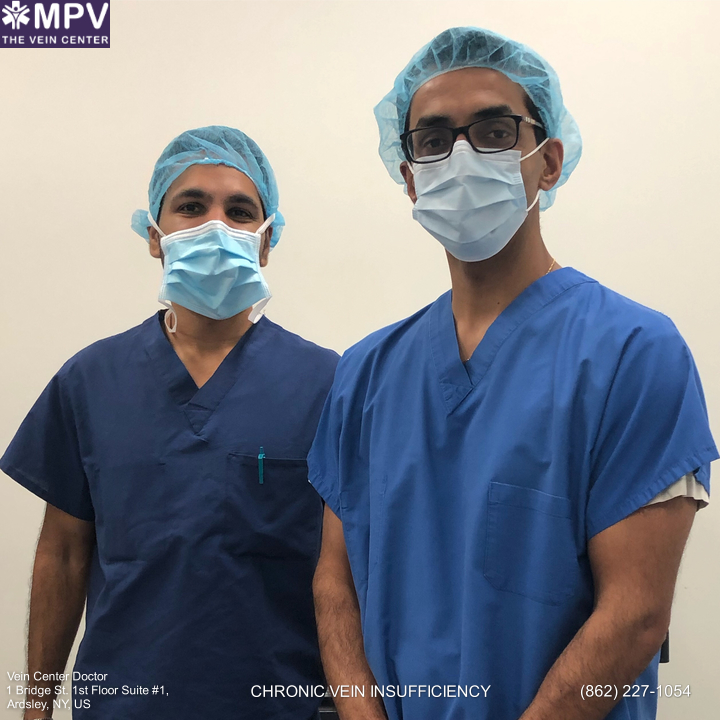
Obstructive sleep apnea in patients with chronic venous insufficiency is a common occurrence because of the pro-coagulation state that links these 2 disease entities, along with other coexisting risk factors and diseases such as increased body mass.
At Vein Center Doctor, we can help improve the signs and symptoms of chronic venous insufficiency through our high-quality outpatient vein care. Our team, led by Dr. Rahul Sood, are professional vein doctors knowledgeable and trained in performing these treatments. It pays to manage your vein disorders as soon as possible. Contact us today for your free consultation.



